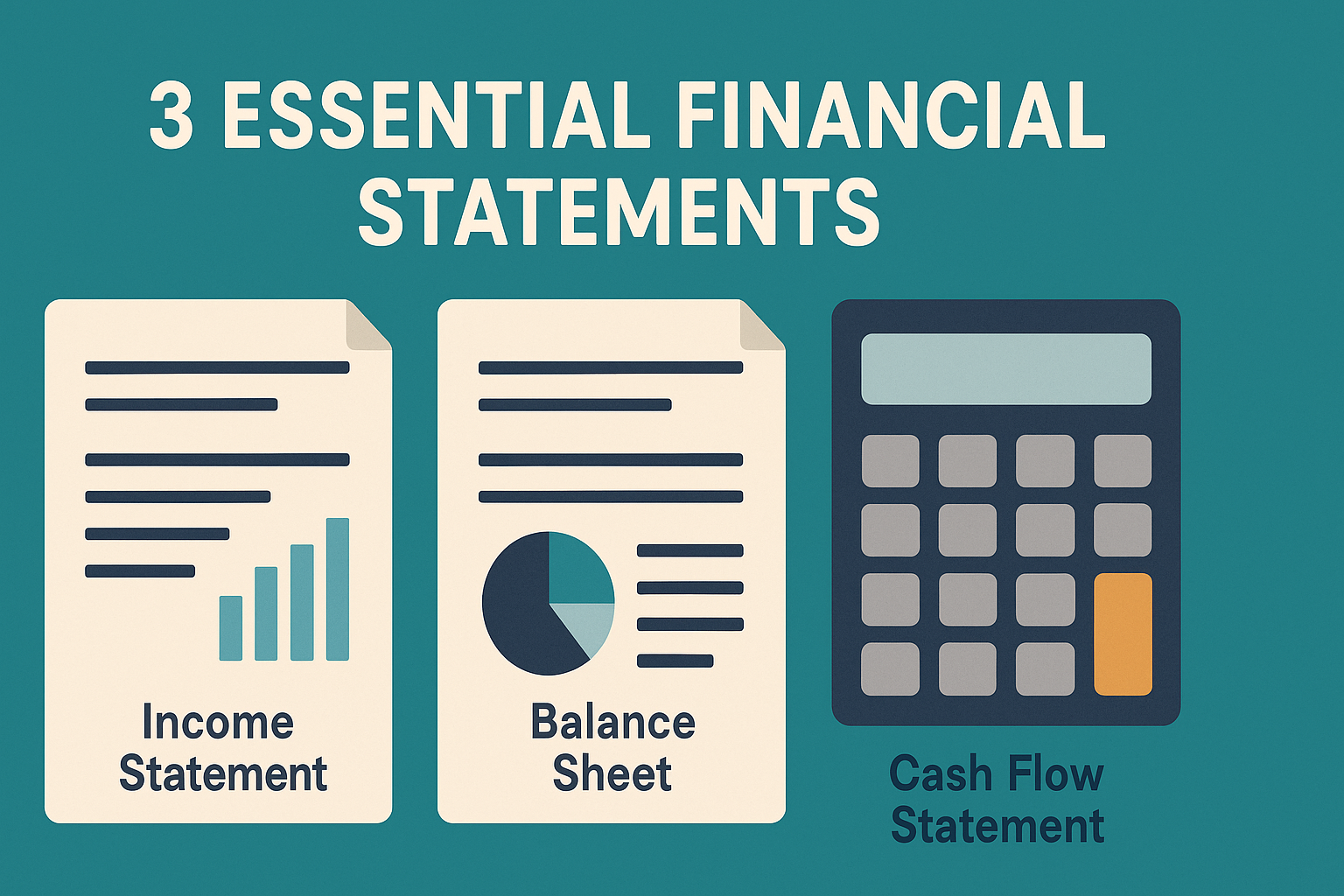The 3 Essential Financial Statements Every Entrepreneur Should Understand
Running a business without understanding your financial statements is like driving a car blindfolded—you might keep moving, but disaster is inevitable. Whether you’re a solopreneur, a startup founder, seasoned business owner or an investor, financial literacy is your most powerful tool for making informed decisions.
At the core of financial clarity are three critical reports: the Income Statement, the Balance Sheet, and the Cash Flow Statement. Together, they reveal your company’s profitability, stability, and liquidity—three pillars that determine whether your business thrives or struggles.
In this guide, we’ll break down each statement, explain why it matters, and show you how to use them to make smarter, data-driven business decisions.
1. Income Statement (Profit & Loss Statement) – Are You Making Money?
What Income Statement Is?
The Income Statement (also called a Profit & Loss Statement or P&L) summarizes your revenues, expenses, and profits (or losses) over a specific period—usually monthly, quarterly, or annually.
This report answers the most fundamental business question: Is my company profitable? Even if sales are booming, high expenses can turn revenue into losses. The P&L helps you spot trends, adjust pricing, and control costs before they spiral.
Key Components:
- Revenue (Sales): Total income from selling products or services.
- Cost of Goods Sold (COGS): Direct costs tied to production (e.g., raw materials, labor).
- Gross Profit: Revenue minus COGS—shows how efficiently you produce goods.
- Operating Expenses: Indirect costs like rent, salaries, marketing, and utilities.
- Net Profit (or Loss): The bottom line after all expenses are deducted.
Entrepreneur’s Takeaway:
- Track trends: Compare monthly P&Ls to see if profits are growing or shrinking.
- Optimize spending: Identify unnecessary expenses eating into profits.
- Adjust pricing: If COGS is too high, consider raising prices or finding cheaper suppliers.
Investor’s Takeaway:
- Evaluate profitability trends: Look for consistent or growing net profits over time—not just one-off gains.
- Assess operational efficiency: Healthy gross profit margins suggest the company is managing production costs well.
- Watch operating expenses: Rising costs without matching revenue growth can signal inefficiency or trouble scaling.
- Spot red flags early: Irregular profits, shrinking margins, or excessive spending may indicate poor financial management.
- Seek sustainability: Favor companies with a clear path to long-term profitability, not just short-term revenue boosts.
- Ask ChatGPT
2. Balance Sheet – What’s Your Business Really Worth?
What Balance Sheet Is?
The Balance Sheet provides a snapshot of your company’s financial health at a specific moment—showing what you own (assets), what you owe (liabilities), and what’s left for the owners (equity).
Profitability doesn’t always equal financial stability. A Balance Sheet reveals whether your business can cover its debts, how leveraged it is, and whether you’re building real value over time.
Key Components:
- Assets (What You Own):
- Current Assets: Cash, inventory, accounts receivable (money owed to you).
- Fixed Assets: Property, equipment, long-term investments.
- Liabilities (What You Owe):
- Current Liabilities: Short-term debts (credit card balances, unpaid bills).
- Long-Term Liabilities: Loans, mortgages, deferred taxes.
- Equity (Owner’s Stake):
- Owner’s Equity = Total Assets – Total Liabilities
Entrepreneur’s Takeaway:
- Monitor solvency: A healthy business has more assets than liabilities.
- Track equity growth: Increasing equity means your business is gaining value.
- Prepare for funding: Investors and lenders scrutinize balance sheets before approving loans.
Investor’s Takeaway:
- Assess financial strength: A strong balance sheet with more assets than liabilities shows a company’s ability to weather downturns.
- Check leverage levels: High debt may increase risk, while low debt with growing equity signals solid financial footing.
- Spot long-term value: Consistent equity growth suggests the business is building sustainable value for shareholders.
3. Cash Flow Statement – Is Your Business Actually Liquid?
What Cash Flow Statement Is:
The Cash Flow Statement tracks real cash moving in and out of your business across three categories: operations, investing, and financing.
Many profitable businesses fail because they run out of cash. This statement shows whether you’re generating enough liquid cash to sustain operations—or if you’re at risk of a cash crunch.
Key Components:
- Operating Activities: Cash from sales, supplier payments, salaries.
- Investing Activities: Purchases/sales of assets (e.g., equipment, property).
- Financing Activities: Loans, investor funding, or dividend payments.
Entrepreneur’s Takeaway:
- Avoid cash traps: High receivables and slow-paying clients can starve your cash flow.
- Plan ahead: Forecast future cash needs to prevent emergencies.
- Improve liquidity: Speed up collections, negotiate better payment terms, or secure a line of credit.
Investor’s Takeaway:
- Gauge liquidity health: A positive cash flow from operations signals a business can sustain itself without relying on debt or investors.
- Spot red flags early: Negative cash flow despite profits may hint at collection issues, overspending, or poor cash management.
- Evaluate capital strategy: Cash flow from investing and financing shows how the company funds growth and manages debt or equity.
Conclusion: Financial Statements = Your Business GPS
Understanding these three reports will help you build a clear roadmap to sustainable growth. Here’s how they work together:
Income Statement: Are you profitable?
Balance Sheet: Are you financially stable?
Cash Flow Statement: Do you have enough cash to operate?
By mastering these statements, you can:
✔ Spot financial risks before they become crises
✔ Make data-driven decisions instead of guesses
✔ Build credibility with investors and lenders
✔ Plan for long-term success with confidence
The more you understand your numbers, the better you can steer your business or investment in the right direction.


Comments